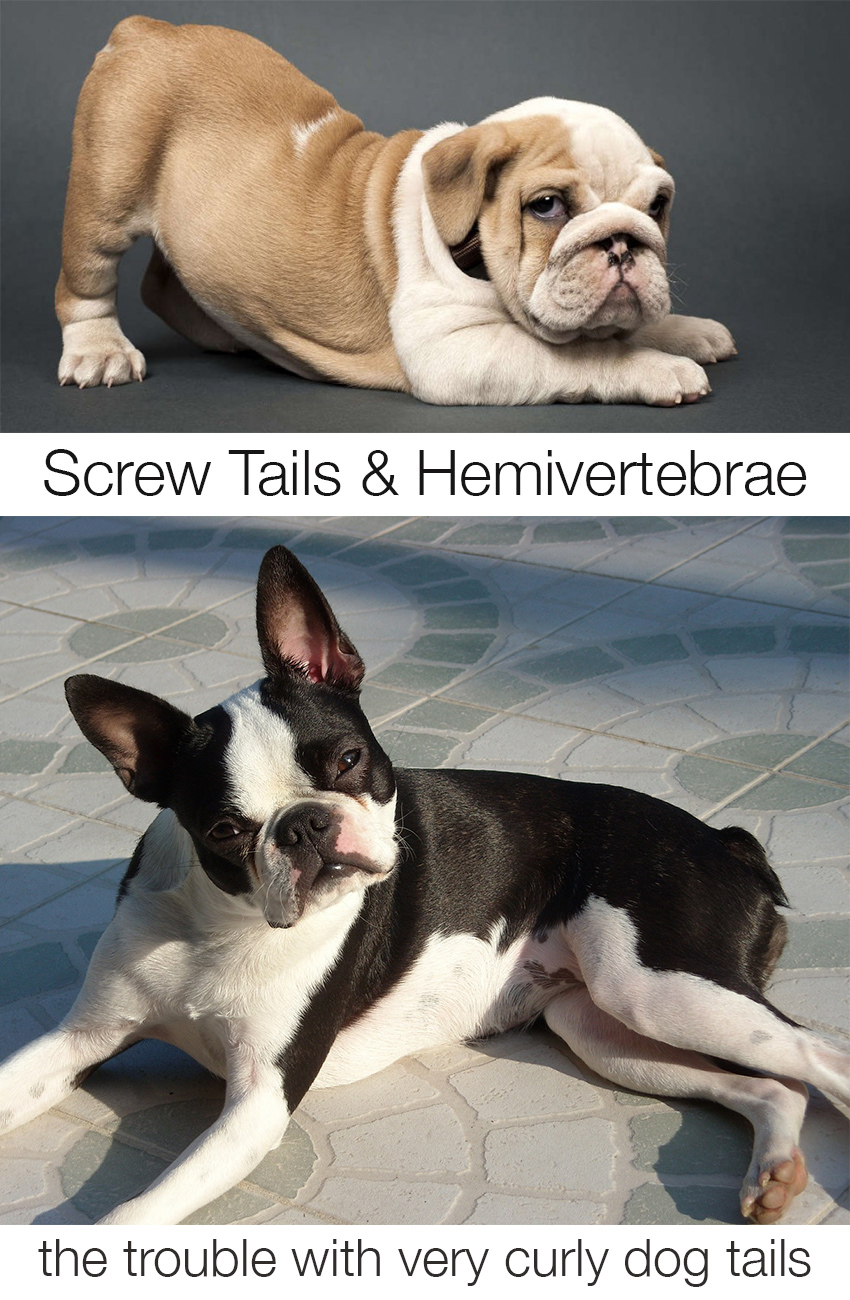You probably know that your dog’s vertebrae are the bones in its spine.
Unlike people, in healthy dogs and puppies, the bones of the spine extend way beyond the pelvis to form a long straight tail.
But there are genes that dogs carry, which can alter the state of that tail to form a corkscrew or curled effect.
But sadly there are some serious adverse effects to the cute curly tail.
Screw tails can come with some serious baggage.
Dogs With Curly Tails
Some breeds of dogs have a natural curl or bend to their tails. But others have been selectively bred to take this curl to an extreme, cork-screw shape.
Dog breeds with curly tails referred to as screw tails include Boston Terriers, Pugs, Bulldogs and French Bulldogs. These dogs often have such a small, curled tail that they appear to be entirely tailless!
If you are thinking of buying or currently own a screw tailed dog breed, you need to be aware of the importance of keeping them clean and the possibility of dealing with hemivertebrae.
Cleaning A Dog’s Screw Tail
If your dog has a screw tail, you must help him to keep it clean. This will reduce the chances of the area becoming dirty or infected.
Every time your puppy poops, you will need to check the tail area.
Curly tails can get very grubby. Especially the small gap underneath the screw tail, where faeces can become lodged.
Use a cotton wool pad or ball, dipped into warm water for the first wipe, and then dry with another clean pad or ball.
This will reduce the dirt, smell and potential for infection in this area.
What Are Hemivertebrae?
Hemivertebrae are malformed spinal bones, or ‘vertebrae’, which are common in dogs with a screw tail.
Hemivertebrae have an odd shape that can cause the whole spinal column to twist.
If these bones are confined to the tail, the twisting may not affect the dog’s spine in any significant way.
But if there are deformed hemivertebrae bones in the main part of the spine, the twisting can put pressure on the spinal nerves that lie within the column of vertebrae and result in neurological problems for the dog.
Hemivertebrae Symptoms
A dog that is suffering from spinal compression due to hemivertebrae may exhibit weakness in his back legs and he may become incontinent. He might even have visible outward signs such as defined scoliosis (curvature of the spine).
He may also suffer from severe back pain, and find it hard to keep his tail clean.
These symptoms may appear in puppyhood in a screwtailed puppy, who will then need to be examined by a veterinary surgeon in order to make a diagnosis. The condition may worsen as the puppy continues to grow.
Hemivertebrae Diagnosis
If you suspect that your puppy might be suffering from hemivertebrae, then you will need to make an appointment to see your veterinarian. She will use an X-ray to confirm the diagnosis.
Once a diagnosis of hemivertebrae has been made, your vet will be in a position to advice you on a programme of treatment.
Hemivertebrae Treatment
Some dogs with hemiverterbrae will never exhibit any symptoms at all, and won’t be adversely affected by the condition. They won’t require any treatment, and will be able to live normal lives. Although it will be advisable not to encourage jumping or other jolting activities, just in case this exacerbates the issue.
Other puppies will be less lucky. Some will be affected mildly, and some may be severely affected.
It may be possible to treat a mildly affected dog with anti-inflammatory drugs. These will reduce swelling and act as painkillers. Giving your dog more freedom of movement and comfort.
Unfortunately though, many significantly affected dogs will need surgery.
Hemivertebrae Surgery
Hemivertebrae surgery is a very specialised procedure and an expensive one. It can be very successful at improving movement, but there can be some immediate or long term complications associated with it.
One of the problems with hemivertebrae surgery, is that it requires anaesthesia. Most dog breeds with curly tails are also brachycephalic.
Subjecting these dogs to anaesthetic procedures is more risky than in breeds with a healthy skull shape, as they have compromised breathing already.
If your dog is diagnosed with hemivertebrae, this something which need to be considered and discussed with your vet before the operation.
Skin Problems With Screw Tails
As we have mentioned above, dogs with screw tails are also susceptible to skin fold infections. Especially where the curl in the tail is very tight.
Sometimes the tail can prevent the dog from pooping hygienically, so it is very important to clean them every day.
Treating Dogs With Infected Tails
In some dogs, the tail may become embedded in a deep skin pocket and be very prone to infection.
Treatment involves careful cleaning, antibiotics where necessary and sometimes amputation of the affected tail.
Hemivertebrae Prevention
Not all screw tailed dogs suffer from spinal compression. Prevention of hemivertebrae is theoretically possible by carrying out X-rays of all breeding stock, and only breeding from dogs free from malformed spinal bones.
However, screw tails are potentially problematical even where the rest of the spine is not affected.
If you are thinking of purchasing a puppy from one of the susceptible breeds, you might want to ensure that both parents have been shown to be clear (by X-ray) of this nasty condition.
The only way to be fairly certain of avoiding the problems discussed on this page is to avoid the corkscrew tailed breeds of dog.
These include the Boston Terrier, the Pug, the Bulldog, and the French Bulldog. You will find that these breeds’ health problems mean that they are a lot more expensive to insure than other dogs.
Hemivertebrae Research
You can find out more about the recent research being carried out into the health of dogs with screw tails below:
- Imaging Findings and Surgical Treatment of Hemivertebrae in Dogs
- Thoracic Kyphosis Associated with Hemivertebra
- Surgical Treatment of Dorsal Hemivertebrae
Does Your Puppy Have A Screw Tail
Has your dog had surgery for hemivertebrae? Does he have an ingrown tail?
If so, sharing your experiences below may help other readers.




Ellyne Fleshner says
We have a 3.5 year old english bull dog. He has a skew tail The pockets are okay but under the tail sometimes gets irritated and bleeds. We clean it with wipes and desitin but I think we need somethng stronger. His balance is fine, it doesn’t smell and he doesn’t scoot. What would you recommend with out surgery.,
Marlene Johnson says
I now own my 7th Boston Terrier. I have grand Boston’s and Great-grand Bostons and have never known of a screw tail problem with any of them. However, my Mugsy who is now 9 has such a screw tail that it is so close to his body that it is covered with his skin. He can wiggle it just fine but often comes to us as we are sitting and wants us to rub his back end with our feet, which seems to feel good to him. Our Vet does not seem to be concerned about it and I do not know what to do for him. Any suggestions?d Thank you!
Holly-Marie says
I have an 11 week old puppy Boston with screw tail, he unfortunately seems to have got the short straw. We are now considering the surgery route. He falls over if you touch his back end, if he turns a certain way he falls, and he really wobbles when he walks. If he loses his footing he’s at risk of falling and rolling down a grass verge. My mistake was not taking him on but believing the breeders and their lies when I bough the him.
Sarah says
I am currently living in South Korea and rescued my 5-7 month old boxer mix from a Buddhist shelter out here. He has a corkscrew tail and I suspect that he is mixed with a pug or English bulldog. It doesn’t impede his pooping and he can wiggle it a little but I will definitely watch for any sign of infection or spinal issues now.
RG says
Well some of us rescue dogs that we mderful beings and want to have them fixed so they can enjoy infection free lives.
Mikki H says
That’s what the breeder was going to do with my boy because he said he was no good to anyone I asked him if I could take him off his hands and he said not for free but he was willing to euthanize him are you kidding me?! So I bought him and signed a contract agreeing to neuter him was going to do that anyways lol
Tracy says
Hi we bought a French bull dog he is now 4 and half months old and his back is archered he looks if he wants worming but he gets a tablet every month he’s slowly putting weight on but his back looks archered stilltoo me his tail goes too one side as well I have asked twice at vets but they have said wait till lol he gets older is there a blood test we could get done too see if he has this curly tail or a defect on his spine he jumps about all over doesn’t seem too be in pain can jump high always running and playing am I being parnoid
Traci says
Hi,
Definitely see a small breed surgical specialist . Our Frenchie who is now 2 yrs old suffered from cork screw tail. As he got older and within 4 months it suddenly got very painful and difficult for him to poo. He has now had the surgery to fix his ongoing health issues . Look for , always scooting bottom on the ground (no it’s not worms ), really bad wind due to the ingrown tail kinking the bowel, trouble pooing , and always getting infections , which start from the bottom but transfer to their feet and eyes , as the dog will lick the areas and reinfect . Also impacted anal glands which can lead to a prolapsed anus. Definitely get the surgery done sooner rather than later. As the problem only gets worse . I wish I had known sooner that this was the problem . But as it occurs internal and creates deep folds this serious condition can go undetected .
Kylee says
We bought a French Bulldog from AARN French Bulldogs LLC in Florida & noticed our dog wouldn’t jump up on the couch or run. When she’d come inside she’d drop to the ground, scoot, & attempt to reach her backside. We thought it might be her anal glands at 1st, this went on for several months until we found a reputable Vet that had experience with these brachycephalic babies. Much to our dismay we soon found out that she suffered from corkscrew tail, which had to be amputated during her spay. Luckily she has recovered fully, runs, jumps, & plays. However, she still drops to the floor & scoots. We love her unconditionally but should’ve done more research about this particular breeder. Buyer beware with this woman for sure.
Meygan Dean says
I just purchased a rescue Frenchie, she is doing the same as your dog. Scooting on the floor and it seems to be itching her. I looked to see what is wrong and it seems that her tail is very red and irritated. What do I do? I cleaned the area and out neosporn on it but what else do I do??? Help please!
JC says
You need to go to the vet. Just brought my 3 yo pug/olde English in and he showed me how irritated and infected the area has become. I now have anti inflammatory by pill and an antibiotic cream
Els says
Totally outrageous to breed dogs to suffer these problems all for looks. Crufts should also be abolished and shame on the breeders . Yet again dogs are used for mans amusement rather than his best friend. Everyone should petition against crafts who support this vile act.
Bruce Cattanach says
There seems little point in breeding for dogs with normal spines when kinked tails are wanted and retained. You are selecting in opposie directions at the same time, like BAER testing Dalmatians for deafness and discarding the hearing pups that are liable to have pigmented patches on the coat, which indicate the probability of greater numbers of pigment cells that are necessary for hearing. Selecting against kinked tails would be effective in reducing the risk of spinal abnormality and this is a very much cheaper option than X-raying.